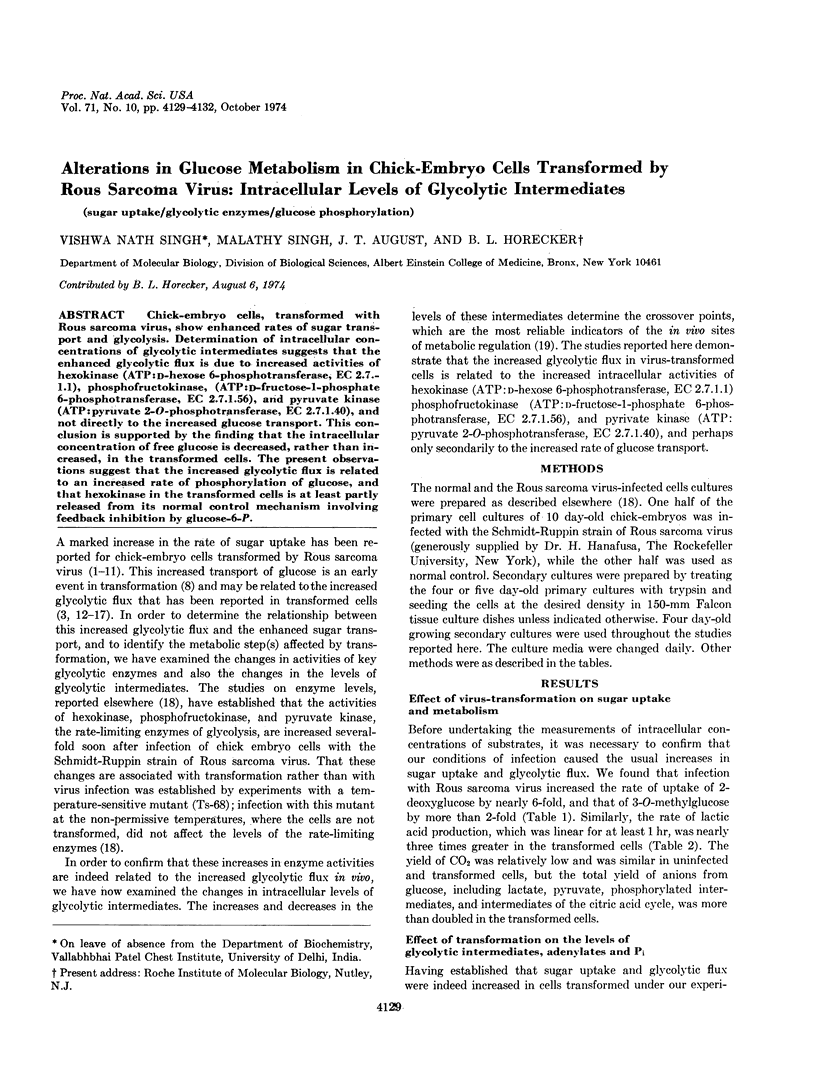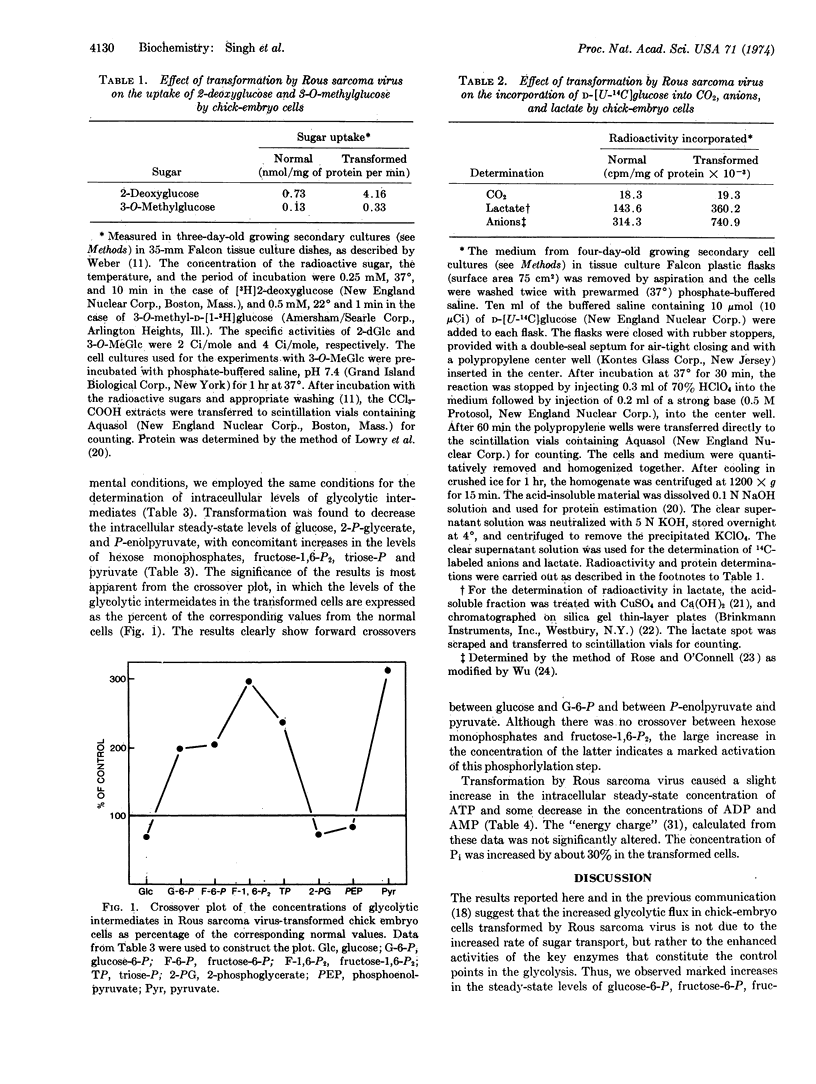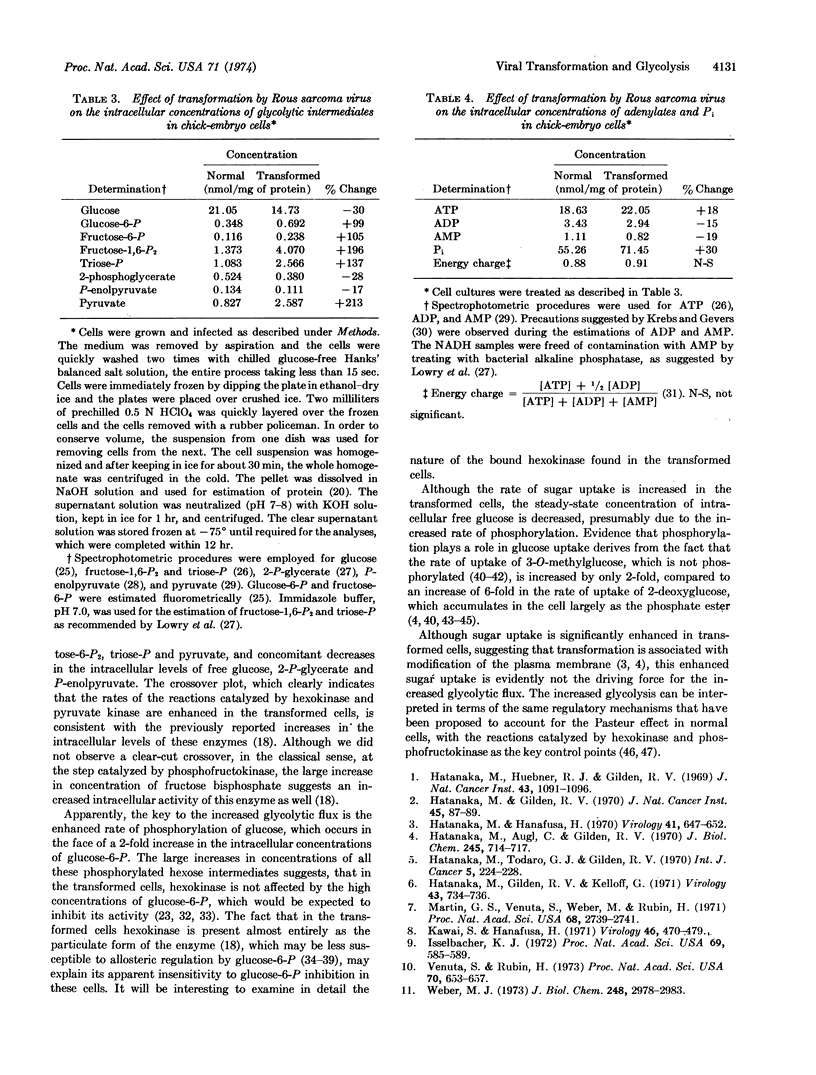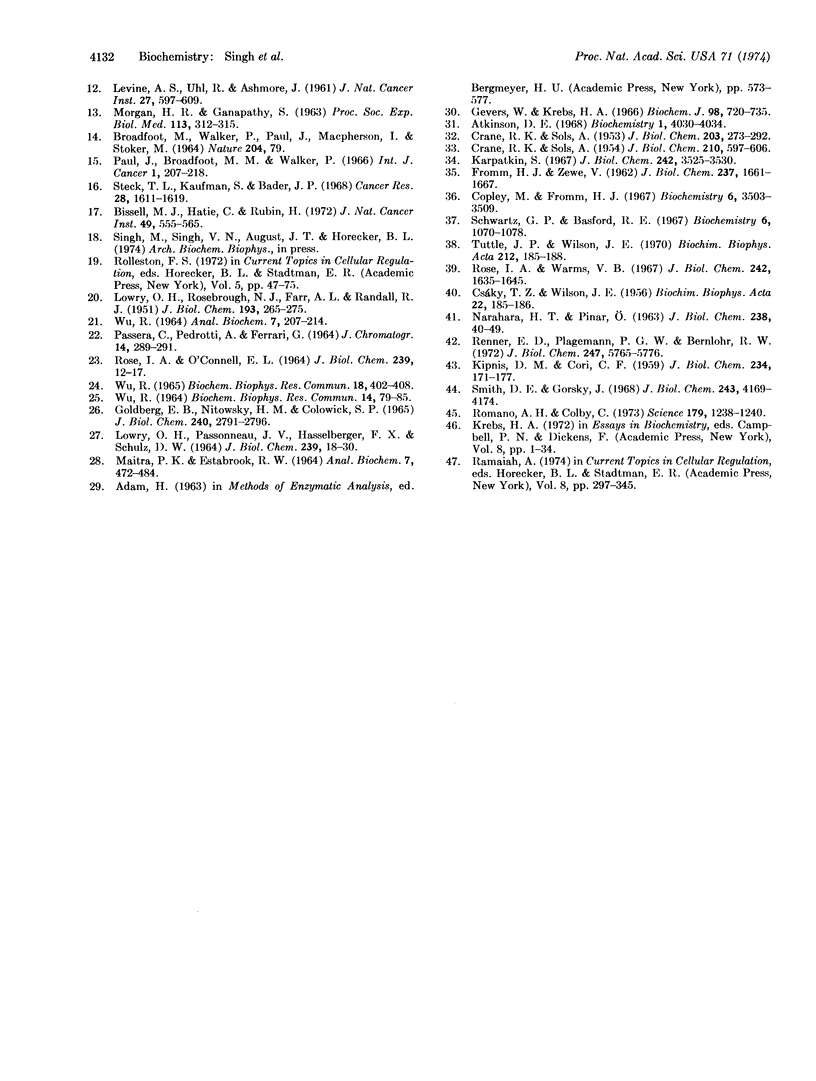Abstract
Chick-embryo cells, transformed with Rous sarcoma virus, show enhanced rates of sugar transport and glycolysis. Determination of intracellular concentrations of glycolytic intermediates suggests that the enhanced glycolytic flux is due to increased activities of hexokinase (ATP:D-hexose 6-phosphotransferase, EC 2.7.1.1), phosphofructokinase, (ATP:D-fructose-1-phosphate 6-phosphotransferase, EC 2.7.1.56), and pyruvate kinase (ATP:pyruvate 2-O-phosphotransferase, EC 2.7.1.40), and not directly to the increased glucose transport. This conclusion is supported by the finding that the intracellular concentration of free glucose is decreased, rather than increased, in the transformed cells. The present observations suggest that the increased glycolytic flux is related to an increased rate of phosphorylation of glucose, and that hexokinase in the transformed cells is at least partly released from its normal control mechanism involving feedback inhibition by glucose-6-P.
Keywords: sugar uptake, glycolytic enzymes, glucose phosphorylation
Full text
PDF



Selected References
These references are in PubMed. This may not be the complete list of references from this article.
- Atkinson D. E. The energy charge of the adenylate pool as a regulatory parameter. Interaction with feedback modifiers. Biochemistry. 1968 Nov;7(11):4030–4034. doi: 10.1021/bi00851a033. [DOI] [PubMed] [Google Scholar]
- BROADFOOT M., WALKER P., PAUL J., MACPHERSON I., STOKER M. GLYCOLYSIS AND RESPIRATION OF TRANSFORMED BHK21 CELLS. Nature. 1964 Oct 3;204:79–79. doi: 10.1038/204079a0. [DOI] [PubMed] [Google Scholar]
- Bissell M. J., Hatié C., Rubin H. Patterns of glucose metabolism in normal and virus-transformed chick cells in tissue culture. J Natl Cancer Inst. 1972 Aug;49(2):555–565. [PubMed] [Google Scholar]
- CRANE R. K., SOLS A. The association of hexokinase with particulate fractions of brain and other tissue homogenates. J Biol Chem. 1953 Jul;203(1):273–292. [PubMed] [Google Scholar]
- CRANE R. K., SOLS A. The non-competitive inhibition of brain hexokinase by glucose-6-phosphate and related compounds. J Biol Chem. 1954 Oct;210(2):597–606. [PubMed] [Google Scholar]
- CSAKY T. Z., WILSON J. E. The fate of 3-O-14CH3-glucose in the rat. Biochim Biophys Acta. 1956 Oct;22(1):185–186. doi: 10.1016/0006-3002(56)90237-2. [DOI] [PubMed] [Google Scholar]
- Copley M., Fromm H. J. Kinetic studies of the brain hexokinase reaction. A reinvestigation with the solubilized bovine enzyme. Biochemistry. 1967 Nov;6(11):3503–3509. doi: 10.1021/bi00863a023. [DOI] [PubMed] [Google Scholar]
- FROMM H. J., ZEWE V. Kinetic studies of the brain hexokinase reaction. J Biol Chem. 1962 May;237:1661–1667. [PubMed] [Google Scholar]
- GOLDBERG E. B., NITOWSKY H. M., COLOWICK S. P. THE ROLE OF GLYCOLYSIS IN THE GROWTH OF TUMOR CELLS. IV. THE BASIS OF GLUCOSE TOXICITY IN OXAMATE-TREATED, CULTURED CELLS. J Biol Chem. 1965 Jul;240:2791–2796. [PubMed] [Google Scholar]
- Gevers W., Krebs H. A. The effects of adenine nucleotides on carbohydrate metabolism in pigeon-liver homogenates. Biochem J. 1966 Mar;98(3):720–735. doi: 10.1042/bj0980720. [DOI] [PMC free article] [PubMed] [Google Scholar]
- Hatanaka M., Augl C., Gilden R. V. Evidence for a functional change in the plasma membrane of murine sarcoma virus-infected mouse embryo cells. Transport and transport-associated phosphorylation of 14C-2-deoxy-D-glucose. J Biol Chem. 1970 Feb 25;245(4):714–717. [PubMed] [Google Scholar]
- Hatanaka M., Gilden R. V., Kelloff G. Induction of sugar uptake by a hamster pseudotype sarcoma virus. Virology. 1971 Mar;43(3):734–736. doi: 10.1016/0042-6822(71)90302-3. [DOI] [PubMed] [Google Scholar]
- Hatanaka M., Gilden R. V. Virus-specified changes in the sugar-transport kinetics of rat embryo cells infected with murine sarcoma virus. J Natl Cancer Inst. 1970 Jul;45(1):87–89. [PubMed] [Google Scholar]
- Hatanaka M., Hanafusa H. Analysis of a functional change in membrane in the process of cell transformation by Rous sarcoma virus; alteration in the characteristics of sugar transport. Virology. 1970 Aug;41(4):647–652. doi: 10.1016/0042-6822(70)90429-0. [DOI] [PubMed] [Google Scholar]
- Hatanaka M., Huebner R. J., Gilden R. V. Alterations in the characteristics of sugar uptake by mouse cells transformed by murine sarcoma viruses. J Natl Cancer Inst. 1969 Nov;43(5):1091–1096. [PubMed] [Google Scholar]
- Hatanaka M., Todaro G. J., Gilden R. V. Altered glucose transport kinetics in murine sarcoma virus-transformed BALB-3T3 clones. Int J Cancer. 1970 Mar 15;5(2):224–228. doi: 10.1002/ijc.2910050209. [DOI] [PubMed] [Google Scholar]
- Isselbacher K. J. Increased uptake of amino acids and 2-deoxy-D-glucose by virus-transformed cells in culture. Proc Natl Acad Sci U S A. 1972 Mar;69(3):585–589. doi: 10.1073/pnas.69.3.585. [DOI] [PMC free article] [PubMed] [Google Scholar]
- KIPNIS D. M., CORI C. F. Studies of tissue permeability. V. The penetration and phosphorylation of 2-deoxyglucose in the rat diaphragm. J Biol Chem. 1959 Jan;234(1):171–177. [PubMed] [Google Scholar]
- Kawai S., Hanafusa H. The effects of reciprocal changes in temperature on the transformed state of cells infected with a rous sarcoma virus mutant. Virology. 1971 Nov;46(2):470–479. doi: 10.1016/0042-6822(71)90047-x. [DOI] [PubMed] [Google Scholar]
- LEVINE A. S., UHL R., ASHMORE J. Glucose metabolism of tumors induced by Rous sarcoma virus. I. Comparison of chorio-allantoic membrane with tumor of the chorioallantois induced by Rous sarcoma virus. J Natl Cancer Inst. 1961 Sep;27:597–609. [PubMed] [Google Scholar]
- LOWRY O. H., PASSONNEAU J. V., HASSELBERGER F. X., SCHULZ D. W. EFFECT OF ISCHEMIA ON KNOWN SUBSTRATES AND COFACTORS OF THE GLYCOLYTIC PATHWAY IN BRAIN. J Biol Chem. 1964 Jan;239:18–30. [PubMed] [Google Scholar]
- LOWRY O. H., ROSEBROUGH N. J., FARR A. L., RANDALL R. J. Protein measurement with the Folin phenol reagent. J Biol Chem. 1951 Nov;193(1):265–275. [PubMed] [Google Scholar]
- MAITRA P. K., ESTABROOK R. W. A FLUOROMETRIC METHOD FOR THE ENZYMIC DETERMINATION OF GLYCOLYTIC INTERMEDIATES. Anal Biochem. 1964 Apr;7:472–484. doi: 10.1016/0003-2697(64)90156-3. [DOI] [PubMed] [Google Scholar]
- Martin G. S., Venuta S., Weber M., Rubin H. Temperature-dependent alterations in sugar transport in cells infected by a temperature-sensitive mutant of Rous sarcoma virus. Proc Natl Acad Sci U S A. 1971 Nov;68(11):2739–2741. doi: 10.1073/pnas.68.11.2739. [DOI] [PMC free article] [PubMed] [Google Scholar]
- NARAHARA H. T., OZAND P. Studies of tissue permeability. IX. The effect of insulin on the penetration of 3-methylglucose-H3 in frog muscle. J Biol Chem. 1963 Jan;238:40–49. [PubMed] [Google Scholar]
- PASSERA C., PEDROTTI A., FERRARI G. THIN-LAYER CHROMATOGRAPHY OF CARBOXYLIC ACIDS AND KETO ACIDS OF BIOLOGICAL INTEREST. J Chromatogr. 1964 Apr;14:289–291. [PubMed] [Google Scholar]
- ROSE I. A., O'CONNELL E. L. THE ROLE OF GLUCOSE 6-PHOSPHATE IN THE REGULATION OF GLUCOSE METABOLISM IN HUMAN ERYTHROCYTES. J Biol Chem. 1964 Jan;239:12–17. [PubMed] [Google Scholar]
- Renner E. D., Plagemann P. G., Bernlohr R. W. Permeation of glucose by simple and facilitated diffusion by Novikoff rat hepatoma cells in suspension culture and its relationship to glucose metabolism. J Biol Chem. 1972 Sep 25;247(18):5765–5776. [PubMed] [Google Scholar]
- Romano A. H., Colby C. SV40 virus transformation of mouse 3T3 cells does not specifically enhance sugar transport. Science. 1973 Mar 23;179(4079):1238–1240. doi: 10.1126/science.179.4079.1238. [DOI] [PubMed] [Google Scholar]
- Rose I. A., Warms J. V. Mitochondrial hexokinase. Release, rebinding, and location. J Biol Chem. 1967 Apr 10;242(7):1635–1645. [PubMed] [Google Scholar]
- Smith D. E., Gorski J. Extrogen control of uterine glucose metabolism. An analysis based on the transport and phosphorylation of 2-deoxyglucose. J Biol Chem. 1968 Aug 25;243(16):4169–4174. [PubMed] [Google Scholar]
- Steck T. L., Kaufman S., Bader J. P. Glycolysis in chick embryo cell cultures transformed by Rous sarcoma virus. Cancer Res. 1968 Aug;28(8):1611–1619. [PubMed] [Google Scholar]
- Tuttle J. P., Wilson J. E. Brain hexokinase: a kinetic comparison of soluble and particulate forms. Biochim Biophys Acta. 1970 Jul 15;212(1):185–188. doi: 10.1016/0005-2744(70)90195-6. [DOI] [PubMed] [Google Scholar]
- WU R. SIMULTANEOUS STUDIES OF PHOSPHATE TRANSPORT AND GLYCOLYSIS BY A SIMPLE LIQUID SCINTILLATION COUNTING PROCEDURE WITH P32, C14, AND H3 COMPOUNDS. Anal Biochem. 1964 Feb;7:207–214. doi: 10.1016/0003-2697(64)90229-5. [DOI] [PubMed] [Google Scholar]
- WU R. THE ROLE OF PI IN THE CONTROL OF GLYCOLYSIS IN ASCITES TUMOR CELLS. Biochem Biophys Res Commun. 1965 Feb 3;18:402–408. doi: 10.1016/0006-291x(65)90721-7. [DOI] [PubMed] [Google Scholar]
- Weber M. J. Hexose transport in normal and in Rous sarcoma virus-transformed cells. J Biol Chem. 1973 May 10;248(9):2978–2983. [PubMed] [Google Scholar]
- Wu R. Control of glycolysis by phosphofructokinase in slices of rat liver, Novikoff hepatoma, and adenocarcinomas. Biochem Biophys Res Commun. 1964;14:79–85. doi: 10.1016/0006-291x(63)90215-8. [DOI] [PubMed] [Google Scholar]


